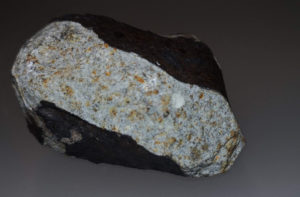A new meteorite with an orbit has been published in Meteoritics & Planetary Science (MAPS): Dishchii’bikoh. It is a rare LL7 chondrite which fell near the city of Cibecue in Arizona / USA, and takes its name as pronounced in the language of the local White Mountain Apache tribe. Several fragments of almost 80 g total mass were recovered using the weather radar footprint of the fall. The orbit of the meteorite is remarkable for being relatively short (1.13 AU semi-major axis) and steeply inclined (ca. 21° to the ecliptic). Radionuclides suggest it was a relatively large meteoroid, at R = 60-100 cm. The cosmic-ray exposure age is quite typical for an ordinary chondrite, at 11 Ma. It seems likely the meteorite derived from the Flora family of asteroids in the inner asteroid belt, similar to other recent LL chondrite falls, like Stubenberg (2016) and Chelyabinsk (2013).
Full disclosure: I am a co-author on the paper. /m4

